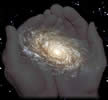| INCO 796: Cosmology and Our View of the World |
| |

|
|
What is consciousness?
Hannelore Moebius
Handout 4/12/199
- Is the universe conscious as a whole?
- Was it conscious when it created itself?
- How different can be consciousness?
- How much consciousness can "something", some body have?
- Think of stones (minerals), plants, animals, and human beings.
- How conscious can be humans? -Quantity, and Quality of mind, sense of self.
- Experience makes aware, consciousness = nothing but awareness, we can deepen by
- practicing mindfulness, Yoga, meditation, etc
- Different states of consciousness: working, sleeping, dreaming, transcending.
- Can we measure and proof consciousness scientifically in mind & body?
- kineseology - healing visualizations - meditation -
- Can we become more effective in community consciousness to heal the world?
Dualistic Models of consciousness:
Mind & matter are essentially different kinds of essences each with its own laws and manner of existence, -divided into three different classes.
- Epiphenomenalism:
- Matter is the real substance of the world. (matter is master, mind is slave)
- Animism:
- Opposite point of view. An invisible spiritual cause lies behind every material motion.
- Material is subordinate to the mind. Everything has inner life.
- Interactionalism:
- Evenhanded form of dualism, mind & matter mutually influence each other.
Monistic models of consciousness:
- Materialism :
- Matter is all that there is. Mind has no specific status, it's just one of matters attributes.
- Mind is to the nervous system as rotation is to the wheel. (Wilson)
- Reductive Materialism:
- Any mechanical motion results in some kind of inner experience. All particles possess a bit of inner life, even atoms are conscious. Reductive Materialism resembles animists, but consciousness is purely mechanical property that we lack the tools to measure.
- Emergent Materialism:
- Consciousness is a wholly mechanical property of matter, but only possessed by complex systems. (experimental scientists, - like Nick Herbert's consc. machine)
- Idealism:
- Mind is the fundamental substance of the world. Experience is mental in character.
- The existence of inner experience is undeniable, but to an idealist the existence of an external world is not certain. World looks like a dream state. (George Berkeley)
- Idealism suggests - developing a wholly mental science based on manipulation and observation of states of consciousness, rather than states of matter.
- Neutral Monism:
- Posits the existence of a single substance possessing both mental and physical attributes.
- Analogy: Electromagnetic field (described by Maxwell), or Light (Eberhard)
- Physicists search for a "Grand Unified Theory" = GUT (= "scientific Yoga" )
These models of the mind also form core assumptions of the world's great religions:
Dualistic -Animistic: Judaism, Christianity, and Islam consider the human soul to be separate from the body. The body is seen as inferior to the soul, even down right evil.
Materialistic: Materialism is part of the scientific enterprise. Atheistic materialism is an active unbelief in God, soul, and afterlife.
Neutral monism: Taoism believes the world inside & outside consists of one substance called TAO (The Way) seeing mind, matter, the self and external objects as incomplete aspects of the single Great Way, and to discover the presence of this way.
Idealism: Idealism is the foundation of Hinduism and Buddhism. The world is viewed as illusion - (Maya), real reality is mental, Braman in Hinduism: consciousness, in Buddhism: Big Mind.
Vedic Scriptures say: The vibration of pure universal consciousness produced the soundless sound of OM. This created the five elements and developed further into our world. Since every thing derives from this vibration, everything must be conscious! Everything is connected through Braman, God, the invisible life energy, which is transcendent.

